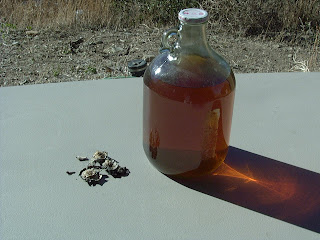Friday, February 25, 2011
GeekDad!
Today I officially became a part of the GeekDad team over at Wired. This gives me the opportunity to flesh out the geek side of my garden geek nature. Check out my first post on using physics to snap off the woody end of an asparagus stem while keeping as much of the tender part as possible. I will still keep posting here so this blog isn't going anywhere.
Thursday, February 3, 2011
Spore Mass Slurry
 |
| Wood chips 2 weeks after addition of spore mass slurry |
Nature seeks equilibrium. This is a concept that can be seen throughout natural systems, but nowhere more evidently than in reproductive rates. Ideally, a natural system, in its most natural state, is in perfect equilibrium. Each individual in the system seeks to replace itself, no more, no less. Sure, all organisms would like to increase their numbers and increase their success, but gone unchecked, this is the path to starvation and disease. Averaged across a population and over centuries, a population in balance with the rest of its environment will average one successful (in this case successful means “grows to adulthood and reproduces”) offspring per mature individual.
Looking at a species’ reproductive strategy can tell you a lot about their place in the ecosystem. Top predators, like wolves and big cats most directly reproduce one to one. Sure, many offspring are produced, but accidents and disease are taken into account and not much else. Rabbits are prey animals. They can produce dozens of offspring in a single year and hundreds in a lifetime. They pay a heavy price to predation, and this must be taken into account in the reproductive strategy. An oak tree can live for hundreds of years. Once it reaches maturity, it can produce thousands of acorns every year. Its reproductive strategy takes into account the squirrels (who plant the acorns) eating most of each year’s crop as well as mortality of oak seedlings.
Mushrooms have among the worst reproductive success out there. A mushroom with a decent source of food can live for 10 years, sometimes much, much more. Each year it can produce dozens of mushrooms. Each mushroom is capable of producing billions (yes, that big number is plural) of spores. Only two spores are needed to reproduce; they must land near each other on a food source, germinate, and then mate to produce a healthy mycelium. How is it that each individual must produce literally trillions of spores to simply replace itself in the ecosystem? Personally I think it speaks to the inefficiency of spores as a reproductive strategy. There is a reason plants moved away from spores and towards seeds as a reproductive device. Spores are just not very effective or very efficient at producing offspring.
Often when I speak to friends about growing mushrooms, their first question is “where do you get the spores?” I have to explain to them that nearly all mushroom cultivation is done by the direct transfer of mycelium from one medium to the next. This is because it is so difficult to successfully and reliably achieve reproduction from spores. However, there are times when spores are available and a good medium for what you are trying to achieve. It is for those times that it is useful to have a method for utilizing the spores that gives them the greatest chance for success. That is when we use a spore mass slurry. A spore mass slurry was a method developed by mycologist Paul Stamets as a way to spread spores over a wide area in a way that helps give them a head start.
The first step is to acquire spores, and that is the hard part. Usually, the best way to acquire spores is from a spore print. If the spore print is taken on glass, the spores can be dried, scraped off, and stored. If the spore print is on paper, the paper can be dried, folded, and stored. You can also add the mushroom directly to the liquid once it has cooled, letting it soak, gills (or pores) down for 4 hours, letting it release its spores directly into the liquid. I have gotten lucky recently and have come across some Coprinus comatus (shaggy mane mushroom) spores. Normally, when shaggy mane mushrooms come up, they quickly deliquesce into an inky, gooey mess, and are gone. Here in Arizona, the exterior of the mushroom dries before the process can complete. The interior still deliquesces, though, only to dry on the inside of the cap. The hollow mushroom that results can be stored. When the spores are needed, it can be immersed. Once wet, the mushroom will deliquesce the rest of the way and the spores will disperse into the surrounding liquid with ease.
 |
| Water with molasses and salt added and mushrooms to be added |
 |
| Spore mass slurry after 48 hours |
Personally, I prefer the use of a spore mass slurry over a mushroom kit for more dispersed growing. For example, many mushrooms are great additions to the garden or compost bin. A spore mass slurry is a good way to spray germinating spores across a wide area and, provided you have access to spores. It can also be a lot less expensive and easier than inoculating with wood chip spawn. You just have to take failure rates into consideration.
Subscribe to:
Comments (Atom)

